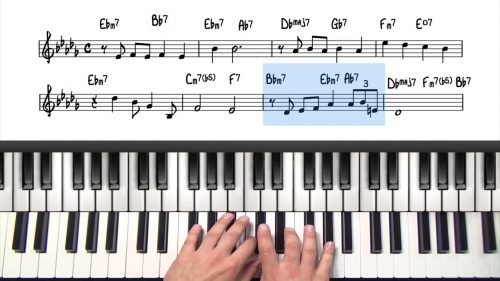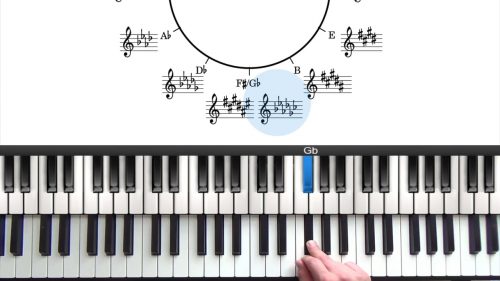Beginner Vocal Exercises – Sing & Play!
Welcome to this tutorial on Singing AND Playing Body and Soul. We are going to learn about incorporating the voice into our playing, right from the beginning of learning a tune.
Do you love to sing?
Singing is something most of us can do and almost as many like to. In this lesson, we are going to address the multi-instrumentalist. The singer and pianist, and talk about the best ways to combine these the talents to get stronger at both.
What a joy to accompany yourself singing, because no one knows you better, or where you are going to go than you do. The singing pianist can meld the piano to the voice like few duos can, and it’s also great for shy singers – which is what I used to be.
Tips & Insight For The Singing Pianist
For those of you who want to pursue the path less traveled in jazz, as the singing pianist, you will find great tips here to help you further your craft.
But these tips are also valuable for those pianists who like to sing, and just want to dig in deeper to the music, to the connection to the piano, to strengthen ear training and internalize the tunes more.
As long as you don’t loathe singing, then I’d advise you to try the methods outlined in this video.
Practice Tips
-
Running through the melody with these exercises is a great way to see if the original key is a good fit for your voice.
-
Since original key is always best, you want to give it a fair shake in your voice to see if it will work.
-
The more times you sing a melody, the more your voice should be able to run smoothly over it. If this isn't happening, it may be an indication that you need to change the key.
-
Make a note if any of the syllables are harder or easier for you on certain notes. I find that Ah or Oh are typically the easiest for most people.
-
When ready, you can move onto the next lesson in this course which contains more advanced exercises for singing AND playing Body and Soul.








This is a FANTASTIC lesson. Thank you Lyndol and Hayden :)
Thanks Natasha…. glad to hear you enjoyed it!
Great lesson! Thanks!! I do have some questions, though.
First, why is the original key always the best?
Second, I have a pretty good idea of what my range is. If I know that a song is out of my range in the original key, and I don’t see a way to change the melody at the “too-high” or “too-low” places in a way that works well with the original melody, can I just transcribe it immediately, learn it in a better key for me (using all the steps you outline in this lesson) and not learn it in the original key? Or — is the tryout in the original key actually a shorter process than I think? I have the sense that it takes at least a week to actually smooth out the playing while singing the correct note names and I don’t want to take all that time if I’m not going to sing that song in that key anyway, ;) Thanks!!
Hey Terese,
Good questions here!
Firstly I wouldn’t say the original key is ‘the best’ key. The best key is the one that fits best with your vocal range. If you can sing the song in the original key it would perhaps make it easier for you to perform the song with other musicians. However, if you are performing with a skilled accompanist he or she would be able to transpose the accompaniment on the fly to accommodate for your choice of key.
For your second question, yes if you know that the melody is out of your range then it makes sense to immediately transpose it into a key that your are more comfortable with.
Finally, yes I agree with your logic regarding the note name drill. Before applying this exercise to a tune it would make sense to identify your most comfortable key to ensure that you are making the most of your practice time.
Lyndol has written a selection of informative posts for singing pianists in her section of the forum:
pianogroove.com/community/c/practice-inspiration/vocal-accompaniment
She also created a dedicated post on vocal range here which gives more information: pianogroove.com/community/t/singers-corner-find-your-vocal-range/2645
Hope this helps and let us know if you have any more questions.
Cheers,
Hayden
Thanks! Are there more lessons like this, with singing and piano?
Hi M. van der Linden 👋🏻
Yes Lyndol has 2 courses on vocal accompaniment, find all of the lessons here:
Course 1: pianogroove.com/jazz-piano-lessons/how-to-accompany-singers/
Course 2: pianogroove.com/jazz-piano-lessons/how-to-sing-play-jazz-piano/
Let me know if I can help further.
Cheers,
Hayden
Thank you for that course. Exactly what i was looking for. A hands on aproach to get to grips with this.
Does anybody have expierience with Solfege (variable pitch) to avoid singing „eflat“ and such. And beeing in relative pitch all the time, therefore beeing able to transpose on the fly, if yuu are up to it at the piano of course, to singers that is quite easy. Of course you have to get very familiar with solfege. Butt one might come up with a completely realtive pitch system as the Nashville number system for both, singing and piano. Maybe an idea to find somebody adept at that and do a seminar or lesson here, might be a benefit to some here.
TThanks
Volker